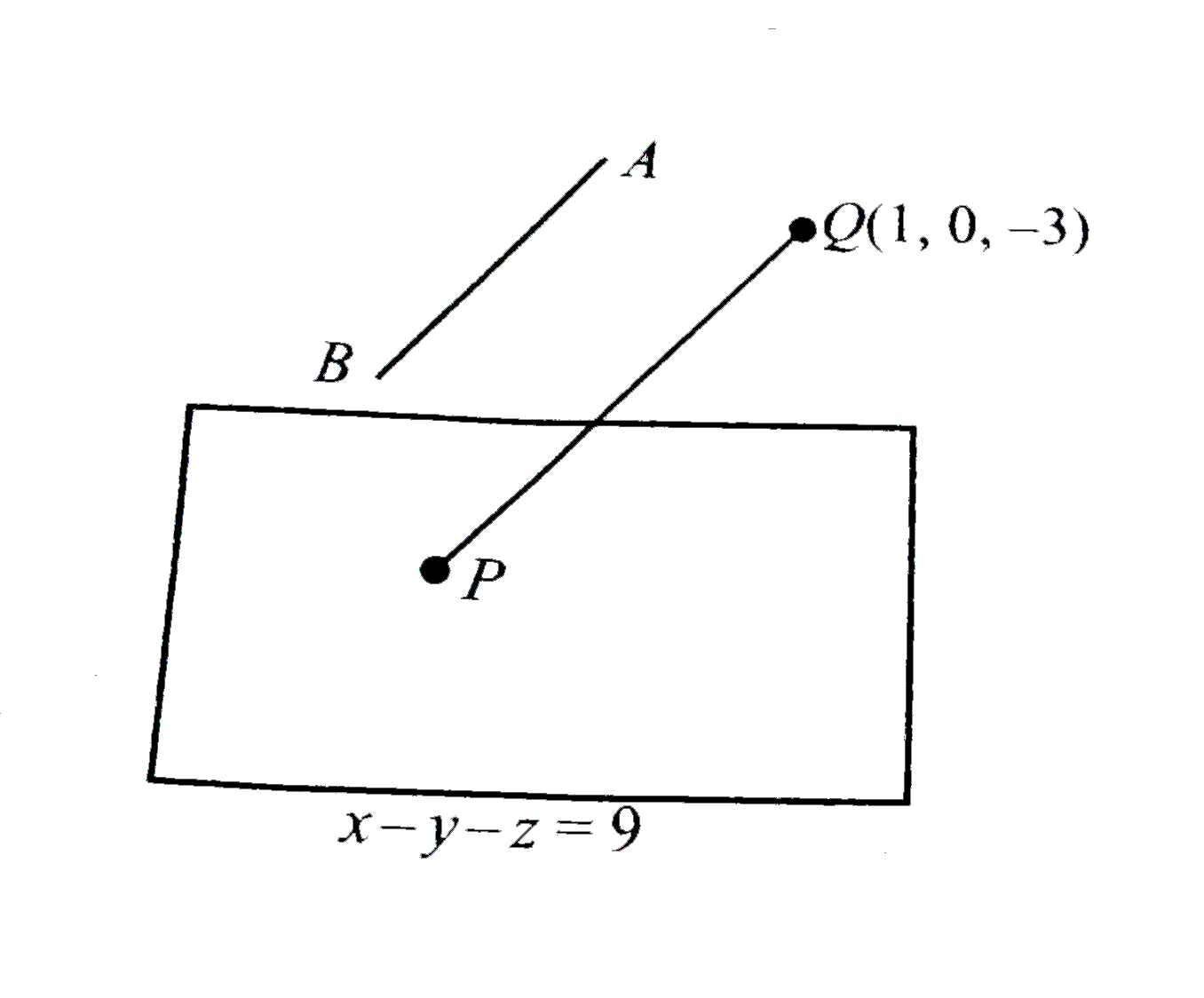Prove that the vectors →a=ˆi+2ˆj+3ˆk and →b=2ˆi−ˆj are perpendicular.Solution in Tamil
The correct Answer is:a→r;b→p;c→q;d→s
The given line and plane are →r=(2ˆi−2ˆj+3ˆk)+λ(ˆi−ˆj+4ˆk)and→r⋅(ˆi+5ˆj+ˆk)=5, respectively. Since (ˆi−ˆj+4ˆk)⋅(ˆi+5ˆj+ˆk)=0, line and plane are parallel.
Hence, the required distance is equal to distance of point (2,−2,3) from the plane x+5y+z−5=0, which is |2−10+3−5|√1+25+1=103√3
b. The distance between two parallel planes →r⋅(2i−j+3k)=4and→r⋅(6i−3j+9k)+13=0 is
d=|4−(−13/3)|√(2)2+(−1)2+(3)2=(25/3)√14
=253√14
c. The perpendicular distance of the point (2,5,−3) fromt the plane →r⋅(6i−3j+2k)=4or6x−3y+2z−4=0 is
d=|12−15−6−4|√36+9+4
=13/√49=13/7
d. The equation of the line AB is
x−22=y+23=z−6−6
The equation of line passing through (1,0,−3) and parallel to AB is
x−12=y3=z+3−6=r (say)

The coordinates of any point on line P(2r+1,3r,−6r−3) which lie on plane
(2r+1)−(3r)−(−6r−3)=9
r=1
Point P≡(3,3,−9)
Required distance
PQ=√(3−1)2+(3−0)2+(−9+3)2
=√4=9+36=7
Topper's Solved these Questions
- BOOK - CENGAGECHAPTER - THREE-DIMENSIONAL GEOMETRY EXERCISE - Exercise (Numerical)10videos
THREE-DIMENSIONAL GEOMETRY
- BOOK - CENGAGECHAPTER - THREE-DIMENSIONAL GEOMETRY EXERCISE - JEE Previous Year26videos
THREE-DIMENSIONAL GEOMETRY
- BOOK - CENGAGECHAPTER - THREE-DIMENSIONAL GEOMETRY EXERCISE - Exercise (Comprehension)12videos
THREE-DIMENSIONAL GEOMETRY
- BOOK - CENGAGECHAPTER - THREE DIMENSIONAL GEOMETRYEXERCISE - Question Bank12videos
THREE DIMENSIONAL GEOMETRY
- BOOK - CENGAGECHAPTER - TRIGNOMETRIC RATIOS IDENTITIES AND TRIGNOMETRIC EQUATIONSEXERCISE - Question Bank4videos
TRIGNOMETRIC RATIOS IDENTITIES AND TRIGNOMETRIC EQUATIONS
Similar Questions
Find the number of sphere of radius r touching the coordinate axes.
05:40View Solution(i) Find the equation of the plane passing through the points(2,1,0),(5,0,1)and(4,11). (ii) If P s the point (2,1,6), then the find the point Q such that PQ is perpendicular to the plane in (i) and the midpoint of PQ lies on it.
03:56View SolutionGiven four points A(2,1,0),B(1,0,1),C(3,0,1)andD(0,0,2). Point D lies on a line L orthogonal to the plane determined by the points A, B and C.
The equation of the plane ABC is01:32View SolutionThe equation of the plane which has the property that the point Q(5,4,5) is the reflection of point P(1,2,3) through that plane, is ax+by+cz=d where a,b,c,d∈N. Find the least value of (a+b+c+d).
02:55View SolutionThe number of solution (s) of the equation
√2+cos2x=(sinx+cosx)∈[−π2,π]06:27View SolutionLet →a=ˆj−ˆk and →c=ˆi−ˆj−ˆk . Then vector →b satisfying →a×→b+→c=→0 and →a.→b=3 is (1) 2→i−→j+2→k (2) ˆi−ˆj−2ˆk (3) ˆi+j−2ˆk (4) −ˆi+ˆj−2ˆk
02:05View SolutionFind the volume of the parallelepiped whose coterminous edges are represented by the vectors: →a=2ˆi+3ˆj+4ˆk,→b=ˆi+2ˆj−ˆk,→c=3ˆi−ˆj+2ˆk →a=2ˆi+3ˆj+4ˆk,→b=ˆi+2ˆj−ˆk,→c=3ˆi−ˆj−2ˆk →a=11ˆi,→b=2ˆj−ˆk,→c=13ˆk →a=ˆi+ˆj+ˆk,→b=ˆi−ˆj+ˆk,→c=ˆi+2ˆj−ˆk
02:18View SolutionIf →a=ˆi+ˆj,→b=ˆj+ˆk,→c=ˆk+ˆi, then in the reciprocal system of vectors →a,→b,→c reciprocal →a of vector →a is a.ˆi+ˆj+ˆk2 b. ˆi−ˆj+ˆk2 c. −ˆi−ˆj+ˆk2 d. ˆi+ˆj−ˆk2
04:09View SolutionThe unit vector perpendicular to →A=2ˆi+3ˆj+ˆk and →B=ˆi−ˆj+ˆk is
03:09View SolutionFind the unit vectors perpendicular to both →a and →b when
(i) →a=3ˆi+ˆj−2ˆk and →b=2ˆi+3ˆj−ˆk
(ii) →a=ˆi−2ˆj+3ˆk and →b=ˆi+2ˆj−ˆk
(iii) →a=ˆi+3ˆj−2ˆk and →b=−ˆi+3ˆk
(iv) →a=4ˆi+2ˆj−ˆk and →b=ˆi+4ˆj−ˆk11:23View Solutionयदि →a=2ˆi+2ˆj+3ˆk,→b=−ˆi+2ˆj+ˆk और →c=3ˆi+ˆj इस प्रकार है कि पर लम्ब है , तो का मान ज्ञात कीजिए।
06:39View SolutionIf →a=ˆi+ˆj+ˆk, →b=2ˆi−ˆj+3ˆk and →c=ˆi−2ˆj+ˆk, find a unit vector parallel to the vector 2→a−→b+3→c
03:59View SolutionIf vectors →a=2ˆi+2ˆj+3ˆk, →b=−ˆi+2ˆj+ˆk and →c=3ˆi+ˆj are such that →a+λ →b is perpendicular to →c, then find the value of λ
02:57View SolutionIf →a=ˆi+ˆj,→b=ˆj+ˆk,→c=ˆk+ˆi, then in the reciprocal system of vectors →a,→b,→c reciprocal →a of vector →a is a.ˆi+ˆj+ˆk2 b. ˆi−ˆj+ˆk2 c. −ˆi−ˆj+ˆk2 d. ˆi+ˆj−ˆk2
04:15View SolutionFind the volume of the parallelepiped whose coterminous edges are represented by the vectors: i,→a=2ˆi+3ˆj+4ˆk,→b=ˆi+2ˆj−ˆk,→c=3ˆi−ˆj+2ˆk ii, →a=2ˆi−3ˆj+4ˆk,→b=ˆi+2ˆj−ˆk,→c=3ˆi−ˆj−2ˆk iii, →a=11ˆi,→b=2ˆj,→c=13ˆk iv, →a=ˆi+ˆj+ˆk,→b=ˆi−ˆj+ˆk,→c=ˆi+2ˆj−ˆk
01:39View Solution

